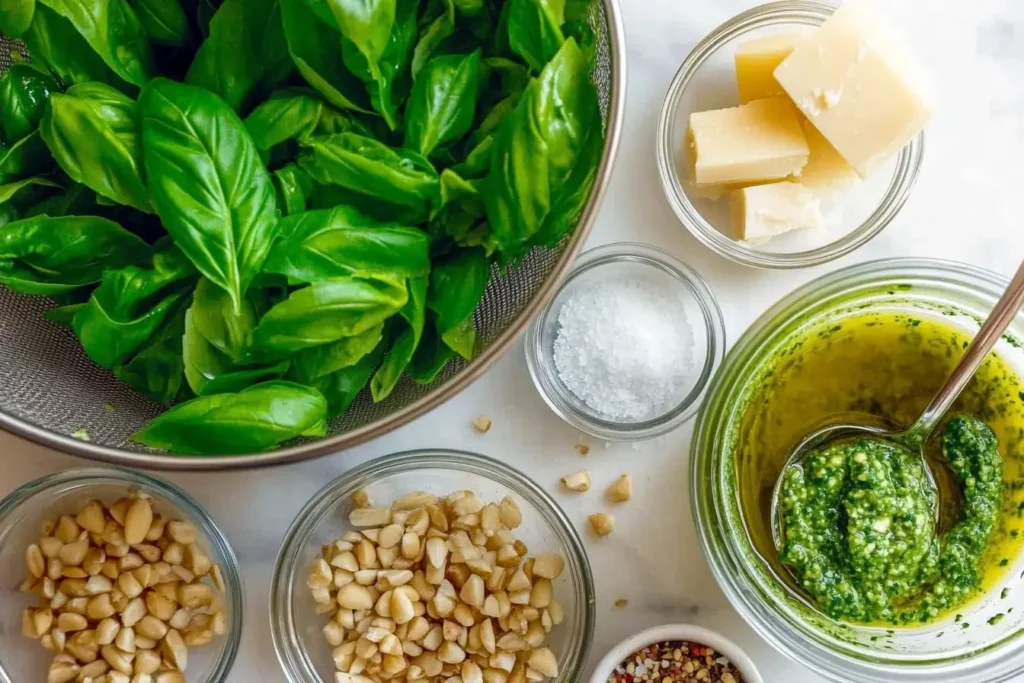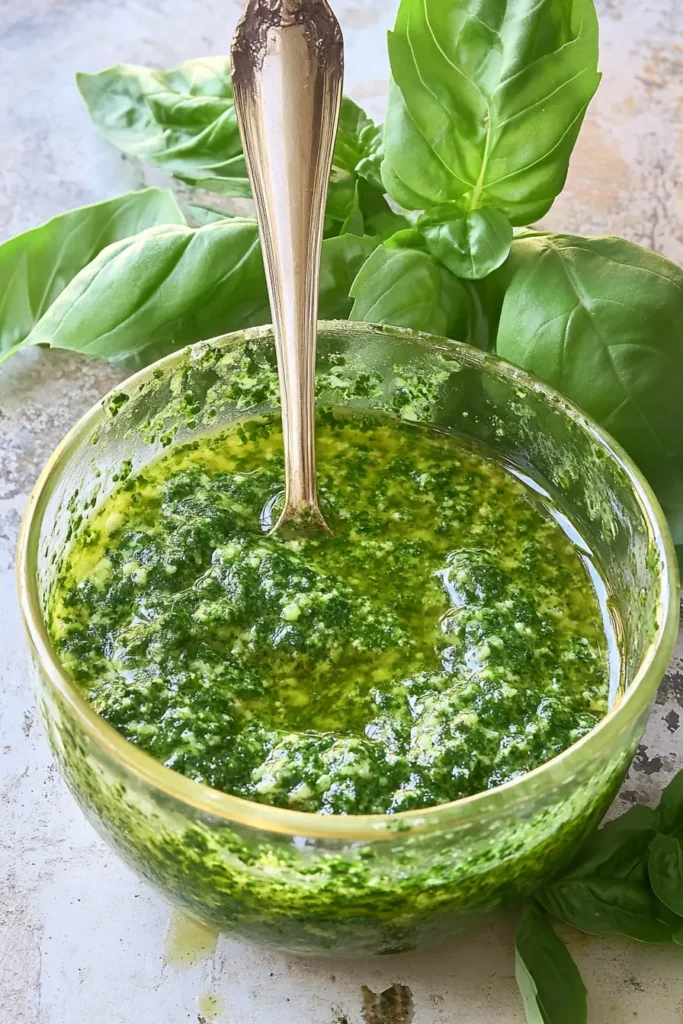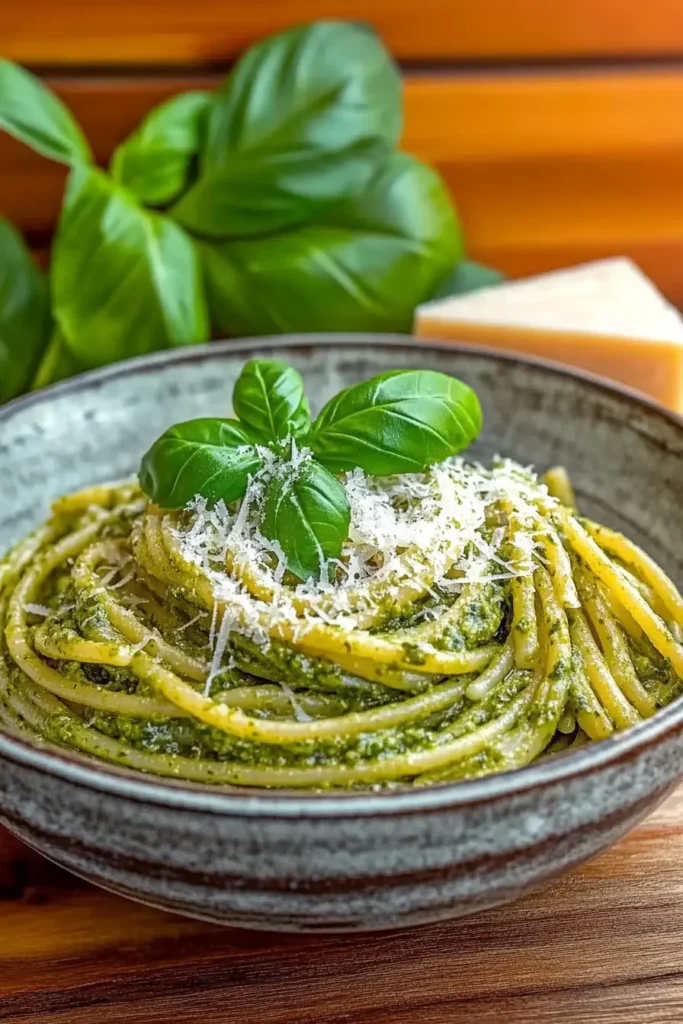🖋️ Written by Emma
Pesto Genovese Recipe is the heart of Italian cuisine, known for its rich, fresh basil flavor and creamy texture. This classic sauce from Liguria combines simple ingredients—basil, garlic, pine nuts, Parmesan, and extra virgin olive oil—yet many home cooks unknowingly make a crucial mistake that ruins its taste and color.
If your Pesto Genovese Recipe turns out bitter, dull, or too thick, you might be making the #1 mistake: overheating the basil. In this guide, we’ll uncover why this happens, how to fix it, and the best techniques for making authentic, restaurant-quality pesto at home.
What is Pesto Genovese?
The Origins of Pesto Genovese
Pesto Genovese Recipe is a centuries-old Italian sauce that originates from the Liguria region, specifically Genoa. The word “pesto” comes from the Italian verb pestare, which means “to crush” or “to pound,” referring to the traditional method of grinding the ingredients using a mortar and pestle.
Historically, Pesto Genovese Recipe was created as a simple yet flavorful way to enhance pasta dishes. Over time, it has become a staple in Italian cuisine and is now enjoyed worldwide for its fresh, aromatic taste.
Traditional Ingredients of Classic Basil Pesto
The authentic Pesto Genovese Recipe consists of just a few high-quality ingredients, each playing a vital role in its flavor and texture:
- Fresh Genovese basil – The star ingredient, providing the signature aroma and taste.
- Extra virgin olive oil – Adds richness and a smooth texture.
- Garlic – Brings a mild, spicy depth to the sauce.
- Pine nuts – Give a creamy, slightly nutty flavor.
- Parmesan (Parmigiano Reggiano) or Pecorino Romano – Enhances the savory, umami taste.
- Salt – Balances and intensifies all the flavors.
By using these fresh and authentic ingredients, you can create a Pesto Genovese Recipe that stays true to its Italian roots. However, even with the best ingredients, one common mistake can ruin your pesto—let’s find out what it is in the next section.
The #1 Mistake People Make with Pesto Genovese
The Biggest Error: Overheating the Basil
When making Pesto Genovese Recipe, the most common mistake that home cooks make is overheating the basil. This happens when using a food processor or blender at high speed, which generates heat and causes the basil to oxidize. As a result, the pesto loses its vibrant green color, turning dark or brownish, and develops a bitter taste.
The key to a perfect Pesto Genovese Recipe is keeping the basil fresh and bright. Traditional Italian chefs always emphasize using a mortar and pestle, as the slow grinding process preserves the natural oils and flavor of the basil without introducing heat.
Why Heat Ruins the Flavor and Color of Pesto
Overheating affects the Pesto Genovese Recipe in several ways:
- Loss of Bright Green Color – Heat causes the chlorophyll in basil to break down, leading to a dull, unappetizing color.
- Bitter or Metallic Taste – When basil is overheated, it releases compounds that create a bitter aftertaste, overpowering the delicate flavors.
- Altered Texture – Blending at high speed can emulsify the oil too much, making the pesto overly thick or even pasty.
If you’ve ever made pesto that looked dark or tasted slightly bitter, chances are you made this exact mistake. But don’t worry—there are simple ways to fix it! In the next section, we’ll show you how to make Pesto Genovese Recipe the right way to maintain its authentic taste and perfect texture.
How to Fix This Mistake for Perfect Pesto

Using a Mortar and Pestle for the Best Texture
The best way to avoid overheating your Pesto Genovese Recipe is by using a mortar and pestle, just as it has been done in Italy for centuries. This method slowly crushes the basil leaves, releasing their essential oils without damaging their delicate structure. The result? A smoother, richer, and more aromatic pesto with an authentic taste.
To make Pesto Genovese Recipe the traditional way:
- Crush garlic and salt in a mortar until it forms a paste.
- Add pine nuts and grind them into the mixture.
- Slowly add basil leaves, pressing them gently with a circular motion to extract their natural flavors.
- Mix in grated Parmesan or Pecorino, blending it into the paste.
- Drizzle in extra virgin olive oil gradually, stirring continuously until smooth.
This process takes a bit more time than using a blender, but it guarantees a fresher, more vibrant pesto.
How to Use a Blender Without Damaging the Basil
If you prefer to use a blender or food processor for your Pesto Genovese Recipe, you can still prevent overheating by following these tips:
- Pulse instead of blending continuously – Short bursts prevent excessive heat buildup.
- Chill the blades beforehand – Place your blender blades in the freezer for 10–15 minutes before use.
- Add the basil last – Start with the garlic, pine nuts, and cheese first, then blend in the basil with oil at the end.
- Use ice cubes – Adding a small ice cube while blending can help keep the temperature low and preserve the basil’s bright green color.
By following these steps, you can ensure your Pesto Genovese Recipe turns out fresh, vibrant, and full of authentic Italian flavor. Next, let’s explore the best type of basil to use for the perfect pesto.
Choosing the Right Basil for Pesto Genovese
Why Genovese Basil is the Best Option
When making an authentic Pesto Genovese Recipe, the choice of basil is crucial. Not all basil varieties produce the same flavor, and using the wrong type can result in a pesto that lacks the signature taste of traditional Italian pesto.
The best basil for a Pesto Genovese Recipe is Genovese basil, which is grown in the Liguria region of Italy. It has small, tender leaves with a delicate, slightly sweet flavor and an intense aroma that makes the pesto smooth and fragrant. Unlike other basil varieties, Genovese basil has less of the spicy or anise-like notes found in some types, allowing it to blend perfectly with garlic, cheese, and pine nuts.
Other Basil Varieties and How They Affect Taste
If you can’t find Genovese basil, here are some alternative basil varieties and how they might impact your Pesto Genovese Recipe:
| Basil Variety | Flavor Profile | Effect on Pesto |
|---|---|---|
| Sweet Basil | Mild, slightly sweet | Closest substitute for Genovese basil |
| Thai Basil | Strong anise, spicy | Alters traditional flavor, not recommended |
| Lemon Basil | Citrusy, fresh | Adds a tangy twist but changes the classic taste |
| Holy Basil | Peppery, clove-like | Too strong and overpowering for pesto |
| Purple Basil | Slightly bitter, earthy | Creates a darker pesto with a different taste |
To get the best results for your Pesto Genovese Recipe, always choose fresh, bright green Genovese basil. If using an alternative, opt for sweet basil, as it has the most similar flavor.
Now that you know which basil to use, let’s explore the best cheese options to make your pesto even more delicious.
Picking the Best Cheese for Authentic Pesto
Parmesan vs. Pecorino: Which One is Better?
When preparing an authentic Pesto Genovese Recipe, choosing the right cheese is just as important as selecting high-quality basil and olive oil. Traditional Italian pesto uses either Parmigiano Reggiano (Parmesan) or Pecorino Romano, or a combination of both, to create a rich and complex flavor.
- Parmigiano Reggiano – Aged for at least 12 months, Parmesan has a nutty, slightly sweet flavor and a smooth, granular texture that blends perfectly into pesto.
- Pecorino Romano – Made from sheep’s milk, Pecorino is saltier and tangier than Parmesan, adding a sharp bite to the Pesto Genovese Recipe.
Most classic Pesto Genovese Recipe variations use a mix of both cheeses—Parmesan for a creamy, nutty base and Pecorino for an extra punch of flavor. If you prefer a milder pesto, use more Parmesan. For a stronger, bolder taste, increase the Pecorino.
How Cheese Influences the Flavor Profile of Pesto
The cheese in a Pesto Genovese Recipe affects more than just taste—it also impacts the texture, saltiness, and overall balance of the sauce.
| Cheese Type | Flavor | Effect on Pesto |
|---|---|---|
| Parmigiano Reggiano | Nutty, slightly sweet | Smooth, balanced taste |
| Pecorino Romano | Sharp, salty | Stronger, bolder pesto |
| Grana Padano | Mild, buttery | Softer, less intense than Parmesan |
| Asiago | Tangy, slightly spicy | Adds depth but alters traditional taste |
For the most authentic Pesto Genovese Recipe, stick with Parmigiano Reggiano and Pecorino Romano, ensuring they are freshly grated for the best texture. Avoid pre-packaged cheese, as it may contain anti-caking agents that can affect the consistency of your pesto.
Now that we’ve covered the best cheese options, let’s discuss why pesto can be expensive and whether the cost is worth it.
Why Pesto Genovese is So Expensive

The Cost of High-Quality Ingredients
One of the reasons a homemade Pesto Genovese Recipe can be expensive is the need for premium, high-quality ingredients. Authentic pesto relies on fresh Genovese basil, extra virgin olive oil, pine nuts, and aged cheeses—all of which can be costly.
- Genovese Basil – This specific variety is often imported or grown under controlled conditions, making it more expensive than regular sweet basil.
- Extra Virgin Olive Oil – The best Pesto Genovese Recipe requires high-quality cold-pressed olive oil, which adds richness but also increases cost.
- Pine Nuts – These nuts are one of the most expensive in the world due to their slow-growing nature and labor-intensive harvesting process.
- Parmesan & Pecorino – Authentic aged cheeses like Parmigiano Reggiano and Pecorino Romano are pricier but essential for true Italian flavor.
Why Traditional Pesto is Worth the Investment
Despite the cost, an authentic Pesto Genovese Recipe is well worth the investment. Store-bought pesto often contains cheaper oils, preservatives, and artificial flavors that can’t compare to the fresh, vibrant taste of homemade pesto.
| Ingredient | Cost Factor | Store-Bought Alternative |
|---|---|---|
| Genovese Basil | Grown in limited regions | Regular sweet basil (less flavorful) |
| Extra Virgin Olive Oil | High-quality cold-pressed | Blended oils (less rich) |
| Pine Nuts | Labor-intensive harvesting | Walnuts or almonds (different taste) |
| Parmesan & Pecorino | Aged, imported cheese | Generic grated cheese (weaker taste) |
If you want the best Pesto Genovese Recipe, it’s worth investing in authentic ingredients to achieve the perfect balance of creaminess, nuttiness, and freshness.
Next, let’s explore the most popular pesto variations in Italy and how Pesto Genovese compares.
The Most Popular Pesto in Italy
Regional Variations of Pesto Across Italy
While the Pesto Genovese Recipe is the most famous and widely recognized, Italy has several regional pesto variations, each offering a unique twist on the classic sauce. Depending on the region, ingredients may differ, but all maintain the signature fresh and aromatic base.
Here are some of the most popular pesto varieties in Italy:
| Pesto Type | Region | Key Ingredients |
|---|---|---|
| Pesto Genovese | Liguria | Basil, garlic, pine nuts, Parmesan, olive oil |
| Pesto alla Siciliana | Sicily | Basil, almonds, tomatoes, ricotta, olive oil |
| Pesto alla Trapanese | Trapani (Sicily) | Basil, tomatoes, almonds, pecorino, garlic, olive oil |
| Pesto di Rucola | Southern Italy | Arugula, walnuts, Parmesan, garlic, olive oil |
| Pesto di Noci | Liguria | Walnuts, garlic, Parmesan, olive oil |
Why Pesto Genovese Remains the Most Beloved
Despite the many variations, the Pesto Genovese Recipe remains Italy’s most iconic and beloved pesto. It is deeply tied to Ligurian cuisine and has been perfected over centuries using only the finest ingredients.
What makes Pesto Genovese Recipe stand out?
- Authenticity – The use of Genovese basil, high-quality Parmesan, and pine nuts ensures an unmistakable flavor.
- Versatility – It pairs perfectly with pasta, meats, seafood, and even bread.
- Simplicity – Unlike other variations that add tomatoes or ricotta, Pesto Genovese Recipe sticks to a simple, well-balanced blend of ingredients.
If you’re looking to experience the true taste of Italy, making an authentic Pesto Genovese Recipe is a must. Now, let’s explore the best ways to store and preserve your homemade pesto to keep it fresh for longer.
Best Ways to Store and Preserve Pesto Genovese
How to Refrigerate Pesto Properly
Storing your Pesto Genovese Recipe correctly is essential to maintaining its vibrant green color and fresh flavor. When exposed to air, pesto oxidizes quickly, turning dark and losing its aromatic qualities.
To store Pesto Genovese Recipe in the refrigerator:
- Use an airtight container – Prevents air exposure and oxidation.
- Cover with olive oil – Add a thin layer of extra virgin olive oil on top to seal in freshness.
- Keep at a stable temperature – Store in the coldest part of the fridge and use within 3-5 days.
Freezing Pesto Without Losing Flavor or Texture
If you want to extend the shelf life of your Pesto Genovese Recipe, freezing is the best option. Proper freezing preserves both the color and taste without altering the texture.
Here’s how to freeze Pesto Genovese Recipe correctly:
- Use ice cube trays – Portion the pesto into cubes, freeze, and transfer to a sealed bag for easy use.
- Avoid adding cheese before freezing – Parmesan and Pecorino can become grainy when frozen. Add them after thawing for a fresher taste.
- Thaw gently – Let pesto defrost in the fridge or at room temperature rather than using heat, which can affect the basil’s delicate flavors.
| Storage Method | Shelf Life | Best For |
|---|---|---|
| Refrigeration | 3-5 days | Immediate use |
| Freezing (no cheese) | Up to 6 months | Long-term storage |
| Freezing (with cheese) | 2-3 months | Short-term storage |
By following these storage techniques, your Pesto Genovese Recipe will stay fresh, flavorful, and ready to use whenever you need it. Now, let’s look at the best ways to enjoy this classic sauce in your favorite dishes!
Delicious Ways to Use Pesto Genovese

Classic Pasta Dishes Featuring Pesto
The most traditional way to enjoy a Pesto Genovese Recipe is with pasta. Ligurians pair pesto with trofie, a short, twisted pasta that holds the sauce perfectly. However, you can also use it with other pasta varieties like linguine, spaghetti, or fusilli.
To serve Pesto Genovese Recipe with pasta:
- Cook pasta al dente – Reserve some pasta water to adjust consistency.
- Mix pesto with a little pasta water – This creates a silky, smooth sauce.
- Never heat pesto directly – Toss with warm pasta instead to preserve the fresh flavor.
- Garnish with extra Parmesan and pine nuts – Enhances taste and texture.
Creative Ways to Incorporate Pesto into Meals
Beyond pasta, Pesto Genovese Recipe is incredibly versatile and can elevate various dishes:
- Spread on toasted bread or bruschetta – A simple yet delicious appetizer.
- Drizzle over grilled meats or seafood – Enhances chicken, shrimp, or salmon.
- Mix into soups or risottos – Adds a fresh, herbal depth of flavor.
- Use as a pizza base – Swap out tomato sauce for a vibrant pesto base.
- Stir into scrambled eggs or omelets – A unique way to infuse flavor into breakfast.
| Dish | How to Use Pesto Genovese |
|---|---|
| Pasta (Trofie, Linguine, Fusilli) | Toss with warm pasta and pasta water |
| Bruschetta or Sandwiches | Spread pesto on bread for added flavor |
| Grilled Chicken or Fish | Drizzle over cooked meat or seafood |
| Soup or Risotto | Stir in at the end for a burst of freshness |
| Pizza | Use as a sauce base instead of tomato sauce |
Whether you keep it classic with pasta or get creative, Pesto Genovese Recipe is a must-have in your kitchen. Now, let’s answer some frequently asked questions about this beloved Italian sauce.
Frequently Asked Questions About Pesto Genovese
What is the difference between pesto and Pesto Genovese?
While “pesto” is a general term for crushed sauces, the Pesto Genovese Recipe refers specifically to the classic basil-based pesto from Genoa, Italy. Other pesto variations, such as Sicilian pesto (which includes tomatoes) or arugula pesto, use different ingredients.
How to make traditional Genovese pesto?
An authentic Pesto Genovese Recipe is made by crushing fresh Genovese basil, garlic, pine nuts, Parmesan (or Pecorino), and extra virgin olive oil using a mortar and pestle. The key is to avoid overheating the basil, which can turn it bitter.
Which basil makes the best pesto?
For the best Pesto Genovese Recipe, use Genovese basil, which has small, tender leaves and a sweet, aromatic flavor. Sweet basil is a good substitute, but avoid strong-flavored varieties like Thai basil.
What is the most popular pesto in Italy?
The Pesto Genovese Recipe is the most famous and widely used pesto in Italy. While other regions have their own versions, such as Sicilian pesto with tomatoes or walnut pesto, Genovese pesto remains the classic and most beloved.
What kind of cheese is best for pesto?
Traditional Pesto Genovese Recipe uses Parmigiano Reggiano or Pecorino Romano. Parmesan provides a mild, nutty taste, while Pecorino adds a sharp, tangy kick. Many recipes use a combination of both for a balanced flavor.
Why is basil pesto so expensive?
The Pesto Genovese Recipe requires high-quality ingredients like fresh basil, extra virgin olive oil, pine nuts, and aged cheese—all of which can be expensive. Pine nuts and authentic Parmigiano Reggiano, in particular, contribute to the higher cost.
By following this guide, you can create an authentic Pesto Genovese Recipe with the perfect balance of flavors and textures. Now, let’s look at the final thoughts and best ways to enjoy your homemade pesto!
Final Thoughts on Pesto Genovese Recipe
Mastering an authentic Pesto Genovese Recipe is all about using the right ingredients and techniques. By avoiding common mistakes—like overheating the basil—and choosing high-quality Genovese basil, extra virgin olive oil, pine nuts, and aged cheese, you can achieve the perfect balance of fresh, nutty, and creamy flavors.
Whether you’re tossing it with pasta, spreading it on bread, or using it as a flavorful drizzle for meats and vegetables, a homemade Pesto Genovese Recipe elevates any dish. Plus, with proper storage methods like refrigeration or freezing, you can always have fresh pesto ready to use.
Now that you know how to make the best Pesto Genovese Recipe, it’s time to gather your ingredients and start creating this Italian classic in your own kitchen!
For more creative baking inspiration and marketing ideas, explore the Facebook



